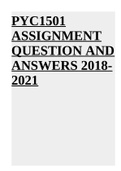PYC1501
ASSIGNMENT
QUESTION AND
ANSWERS 2018-
2021
,PYC1501 ASSIGNMENT QUESTION AND ANSWERS 2018-2021
PYC1501 – 2020 – ASSIGNMENT 1 (answers taken from TL)
Question 1 – 6 refer to the following scenario: A tutor for the first-year psychology group is
dealing with the topic of impulse conduction in the human nervous system. The tutor gives
the students the following questions to test their knowledge of the study material they were
asked to prepare for the class.
Question 1
The part(s) of the neuron that (is) are responsible for receiving information signals, (is) are
called . . .
1. dendrites
2. boutons
3. myelin
4. all of the above
Question 2
The part of the neuron that facilitates synaptic transmission of a signal to another neuron is
...
1. dendrite
2. terminal bouton
3. soma
4. myelin sheath
Question 3
The electrical charge resulting from the difference between the positive and negative ions
outside and inside the cell membrane is called . . .
1. the action potential
2. a high threshold
3. the resting membrane potential
4. the refractory period
Question 4
Which of the statements about the following diagram is/are correct?
1. In accordance with the all-ornone-law, neurons A, B, C and D will
conduct an impulse at exactly the same speed, or not at all.
2. In comparison with neurons A, C and D, neuron B can conduct impulses at the highest
speed and amplitude.
3. In comparison with neurons A, B and C, neuron D will conduct impulses at the highest
frequency.
4. 1 & 3
Page 1
,PYC1501 ASSIGNMENT QUESTION AND ANSWERS 2013 - 2017
Question 5
The opening across which one neuron communicates with another neuron is known as the
...
1. threshold
2. channel
3. synaptic cleft
4. membrane
Question 6
The tutor asks the group what the term “refractory period” means. One of the students said
that it is a phase when the neuron is not ready to fire. Evaluate this answer. The statement
is . . .
1. not correct because the refractory period refers to the phase between the action
potential and the
resting potential
2. not correct because the refractory period refers to the phase when the neuron is ready
to fire
3. partially correct, because the neuron is unable to fire during the absolute refractory
period
4. correct, because the neuron is not ready to fire during the refractory period.
Question 7
The tutor asks the group to draw up a flow chart to illustrate the process of synaptic
transmission. Is this an appropriate way to illustrate synaptic transmission?
1. no, because a diagram should be used to represent the process
2. yes, because a flow chart should provide a great deal of detailed information
3. yes, because a flow chart should provide an overview of the process it illustrates
4. yes, because the flow of information goes in one direction only
Question 8
Which of the following illustrates the correct sequence of events in the process of synaptic
transmission?
1. nerve impulse stimulates bouton, neurotransmitter diffuses across synaptic cleft,
vesicles attach to presynaptic membrane
2. nerve impulse stimulates bouton, transmitter deactivated by bouton, electrical changes
in receiving cell
3. nerve impulse stimulates bouton, vesicles attach to membrane, neurotransmitters
released and attach to receptors on postsynaptic membrane
Page 2
, PYC1501 ASSIGNMENT QUESTION AND ANSWERS 2013 - 2017
4. nerve impulse stimulates bouton, neurotransmitters attach to receptors,
neurotransmitters cross synaptic cleft
Question 9
During synaptic transmission, several excitatory inputs are required to overcome
resistance and produce an impulse in the postsynaptic neuron. The tutor asks the students
to select the correct term used to describe the occurrence when such an impulse is
produced by simultaneous inputs from different neurons.
1. spatial summation
2. inhibition
3. temporal summation
4. excitation
Question 10
The tutor asks students what determines whether a neurotransmitter will have an inhibitory
or excitatory effect. One student answers that it depends on the nature of the
neurotransmitter. This statement . . .
1. does not provide the correct answer because it is too vague
2. is correct because the effect depends on the quantity of the neurotransmitter in relation
to the enzyme that destroys it
3. is partially correct, because other factors also play a role
4. is not correct because the effect depends on the ratio of inhibitory to excitatory
neurotransmitters in a specific synapse.
The tutor asks the students to draw up questions (11 - 14) for a quiz on the topic of
synaptic transmission, to help them prepare for the exam.
Question 11
This neurotransmitter is released by sympathetic nerves and acts on the heart, blood
vessels, large skeletal muscles and accelerates metabolism.
1. acetylcholine
2. serotonin
3. adrenalin
4. endorphin
Question 12
Drugs work through their effects on synaptic processes. The effects are brought about
because drugs . . .neurotransmitters.
1. inhibit
2. facilitate
Page 3




